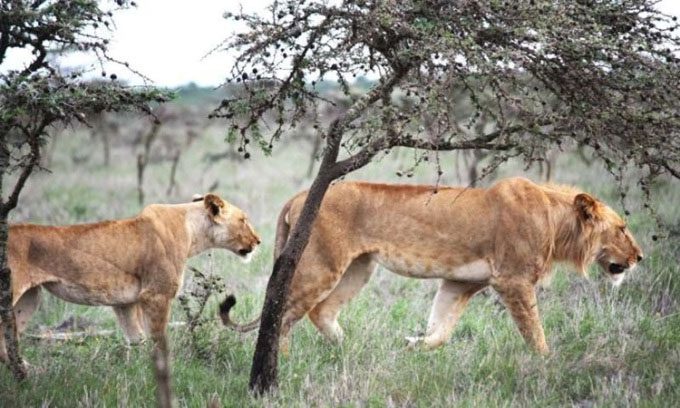Researchers have discovered an invasive ant species that is triggering a chain reaction threatening lions, as they are losing their hiding spots to ambush prey.
In a study published in the journal Science, a team of scientists found that a tiny, harmless invasive ant species is altering the canopy in the wilds of East Africa, making it harder for lions, the world’s most famous predators, to hunt their preferred prey, zebras, Phys.org reported on January 25. “This tiny invasive species is pulling apart the bonds that connect Africa’s ecosystem together, determining which animals are preyed upon and where,” said Todd Palmer, an ecologist and professor in the Department of Biology at the University of Florida.

Invasive ants are reducing canopy cover for lions. (Photo: Todd Palmer).
The research, lasting over three decades, combined hidden camera traps, satellite collar tracking for lions, and statistical modeling. The results reflect the complex web of interactions among ants, trees, elephants, lions, zebras, and buffalo. The chaos began with acacia trees in the Ol Pejeta Conservancy in central Kenya. These trees are protected from leaf-eating animals by an ant species that nests in their swollen thorns. In return for their habitat, the ants actively defend the trees from elephants, giraffes, and other herbivores. This is an arrangement that ecologists refer to as mutualism.
In the early 2000s, Palmer began investigating the complex mutualistic relationships between trees and animals in East Africa. He and his colleagues noted that the tiny ants play a critical protective role, stabilizing the canopy in the region, allowing acacia trees to survive in areas with an abundance of large herbivorous mammals.
However, in the latest study, scientists discovered the emergence of an invasive insect called the big-headed ant (Pheidole megacephala) that triggers a chain reaction, leading to changes in behavior between predators and prey, which could threaten lion populations that are already on the brink of extinction. Big-headed ants are tiny but voracious insect predators that destroy the protective ant nests of the trees without preventing large animals from eating the leaves. With the loss of their guards, the acacia trees are stripped of their leaves by elephants.
Lions, ambush predators, rely on the canopy for concealment as they stalk prey before pouncing on zebras. Less canopy means that lions find it harder to successfully ambush their prey. Lions are shifting their attention to buffalo. However, buffalo are larger than zebras and tend to gather in herds, making them much more formidable prey.
The field study in Kenya was conducted by a scientist and Ph.D. candidate at the University of Wyoming alongside Kenyan scientist Douglas Kamaru. Palmer, along with Jake Goheen from the University of Wyoming and Corinna Riginos from The Nature Conservancy, are co-authors of the study. In addition to investigating the phenomenon, the team of experts indicated they also aim to find solutions to prevent canopy loss in East Africa.



















































